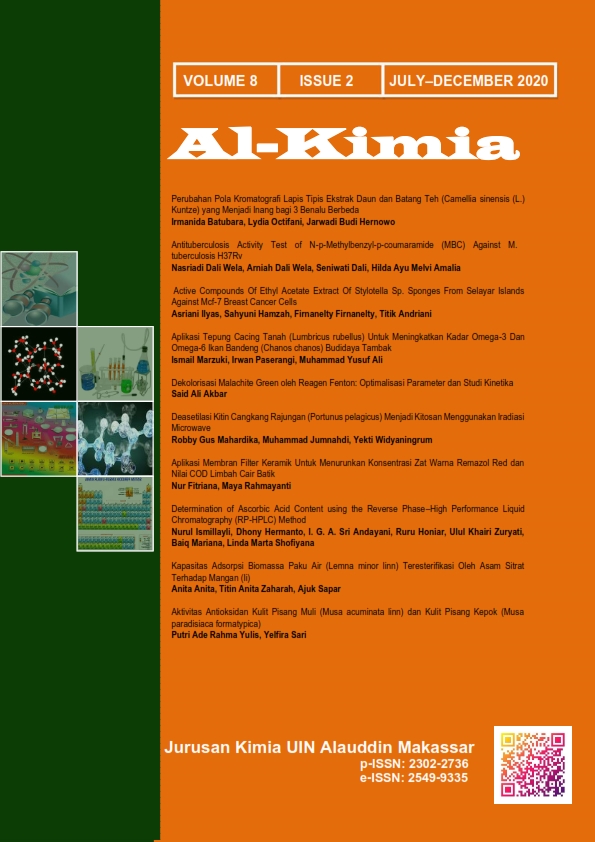Kapasitas Adsorpsi Biomassa Paku Air (Lemna minor linn) Teresterifikasi Oleh Asam Sitrat Terhadap Mangan(Ii)
Abstrak
Research on the adsorption of Mn (II) ions has been carried out using biomass duckweed (Lemna minor linn) with the esterified by citric acid. This study aims to determine the maximum adsorption capacity of Mn (II) ions in using adsorbent biomass of duckweed esterified by citric acid. Water nail biomass adsorbents were characterized using FTIR to determine the functional groups of citric acid esterified adsorbents. The stages of this research include modification of water biomass using citric acid, followed by manganese (II) ion adsorption tests with pH variations in pH, contact time of adsorption and initial concentration variations under optimum conditions. The results showed that optimum adsorption occurred at pH 5, contact time for 10 minutes and the concentration of Mn (II) solution 15 mg / L was measured using atomic absorption spectrophotometry. The equation used in the study follows the Langmuir and Freundlich equations. Based on the Langmuir isotherm equation, the maximum adsorption capacity of Mn (II) ion using citric acid modified water nail biomass is 7,645 mg/ g, the equilibrium constant is 4,317 L/ mol and the adsorption energy is 36,84039 KJ / mol.
##plugins.generic.usageStats.downloads##
Referensi
Anis, Sofiyani and, and Gusrizal. 2006. “Deternation Of pH Effect And Capacity Of Heavy Metals Adsorption By Water Hyacinth ( Eichhornia Crassipes ) Biomass Pengaruh pH Dan Penentuan Kapasitas Adsorpsi Logam Berat.” Langmuir 6(1): 56–60.
Apriyanti, Hesti, I Nyoman Candra, and Elvinawati. 2018. “Karakteristik Isoterm Adsorpsi Dari Ion Logam Besi (Fe) Pada Tanah Di Kota Bengkulu.” ALOTROP Jurnal Pendidikan dan Ilmu Kimia 2(1): 14–19.
Azhari, Mayasari, Chairul Saleh, and Bohari Yusuf. 2017. “Pemanfaatan Serbuk Eceng Gondok (Eichornia Crassipes) Teraktivasi Dengan Sistem Kantong Celup Sebagai Adsorben Penjerap Ion Logam Kadmium (Cd).” Jurnal Atomik 02(2): 197–203.
Budiajanto, Slamet, Hasbullah Rokhani, Setyadjid Prabawati, and Sulusi. 2007. “Pengembangan Dan Pemanfaatan Asap Cair Tempurung Kelapa Untuk Pengawetan Produk Buah-Buahan.” Ringkasan Eksekutif Hasil-hasil Penelitian: 3.
Darmayanti, Lita, Suprihatno Notodarmodjo, and Enri Damanhuri. 2018. “Penyisihan Logam Cu (II) Dari Larutan Dengan Fly Ash Batu Bara.” Jurnal Neo Teknika 4(1): 30–38.
Dwi, Latifah, Kartika Nurfitriningsih, Danar Purwonugroho, and Mohammad Misbah Khunur. 2014. “Modifikasi Gugus Aktif Permukaan Biomassa.” 2(2): 527–33.
Fakhrudin, Juli Nurdiana, and Dyah Wahyu Wijayanti. 2017. “Analisis Penurunan Kadar Cr (Chromium), Fe (Besi) Dan Mn (Mangan) Pada Limbah Cair Laboratorium Teknologi Lingkungan Fakultas Teknik Universitas Mulawarman Samarinda Dengan Menggunakan Metode Elektrolisis.” Prosiding Seminar Nasional Teknologi IV (November): 10–15.
Isnaini, Yulia Nur et al. “Adsorpsi Kadmium ( II ) Menggunakan Biomassa Azolla Microphylla Diesterifikasi Dengan Asam Sitrat: Kajian Pengaruh Konsentrasi Asam Sitrat dan Temperatur Esterifikasi Pendahuluan Logam Kadmium ( Cd ) Merupakan Salah Satu Logam Berat Yang Dalam Kadar Tert.” 1(1): 697–703.
Khoramabadi, Gh Shams, A. Jafari, and J. Hasanvand Jamshidi. 2008. “Biosorption of Mercury (II) from Aqueous Solutions by Zygnema Fanicum Algae.” Journal of Applied Sciences 8(11): 2168–72.
Mao, Juan et al. 2009. “Surface Modification of the Corynebacterium Glutamicum Biomass to Increase Carboxyl Binding Site for Basic Dye Molecules.” Biochemical Engineering Journal 46(1): 1–6.
Miningsih, Nanik Andar et al. 2016. “Adsorpsi Timbal (Pb) Dalam Larutan Menggunakan Adsorben Radix Alang-alang (Imperata Cylindrica) Termodifikasi Asam Sitrat.” Prosiding SNST 7: 23–27.
Purwonugroho, Danar., Ria Septiani. Sinaga, and Darjito. 2015. “Adsorpsi Seng(Ii) Oleh Biomassa Azolla Microphylla Diesterifikasi Dengan Asam Sitrat: Kajian Desorpsi Menggunakan Larutan HCl.” Kimia Student Journal Universitas Brawijaya 1(1): 629–35.
S.Tangio, Julhim. 2012. “Laporan Penelitian Dosen Pemula Adsorpsi Logam Timbal (Pb) Dengan Menggunakan Biomassa Enceng Gondok (Eichhornia Crassipes).” Laporan Penelitian: 1–25.
Tiemann, K J et al. 1998. “Investigation of Metal Binding in Alfalfa Biomass through Chemical Modification of Amino and Sulfhydryl Ligands.” Proceedings of the 1998 Conference on Hazardous Waste Research (915): 111–21.
Wardatul Rahma, Diana Vanda Wellia dan Zulhadjri Syukri Arief*. 2015. “Adsorpsi Pb (II) Menggunakan Biomassa Genjer (Limnocharis Flava).” Prosiding Semitara (2): 710–18.
Authors who publish with this journal agree to the following terms:
1) Authors retain copyright and grant the journal right of first publication with the work simultaneously licensed under a Creative Commons Attribution License that allows others to share the work with an acknowledgement of the work's authorship and initial publication in this journal.
2) Authors are able to enter into separate, additional contractual arrangements for the non-exclusive distribution of the journal's published version of the work (e.g., post it to an institutional repository or publish it in a book), with an acknowledgement of its initial publication in this journal.
3)Authors are permitted and encouraged to post their work online (e.g., in institutional repositories or on their website) prior to and during the submission process, as it can lead to productive exchanges, as well as earlier and greater citation of published work (See The Effect of Open Access).


